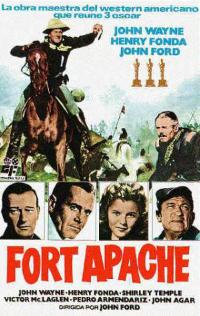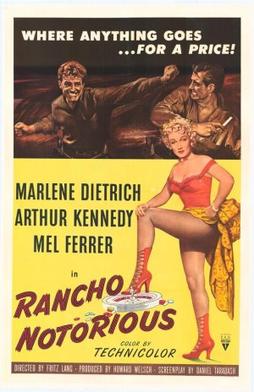Have you already watched the first ten movies we recommended to start your journey to the West? Here’s the second part of Mik‘s selection of classics, containing 10 of his all-time favorites: this time we’ll start off with John Ford’s Cavalry trilogy, discover Anthony Mann’s psychological Western, explore Fritz Lang’s expressionist twist, and other classics not to be missed to get an ideal overview of the world of western cinema.
Mik’s choice of BEST
WESTERN MOVIES, 11-20
| Titolo | Regista | Anno |
|---|---|---|
| Fort Apache | John Ford | 1948 |
| She Wore a Yellow Ribbon | John Ford | 1949 |
| Rio Grande | John Ford | 1950 |
| Bend Of The River | Anthony Mann | 1952 |
| Rancho Notorious | Fritz Lang | 1952 |
| Vera Cruz | Robert Aldrich | 1954 |
| The Hanging Tree | Delmer Daves | 1959 |
| Rio Bravo | Howard Hawks | 1959 |
| The Man Who Shot Liberty Valance | John Ford | 1962 |
| The Wild Bunch | Sam Peckinpah | 1969 |
Fort Apache by John Ford (1948)
With Henry Fonda, John Wayne, Shirley Temple; b&w, 125 min

Cruel and ambitious colonel Thursday, disappointed with his assignment to the remote cavalry post of Fort Apache, is determined to show off his valor in a bloody clash with the Apaches despite being advised against it by Captain York. The film is inspired by the novel Massacre by James Warner Bellah, which depicts the Battle at Little Bighorn where Liutenant Colonel Custer was defeated by Sitting Bull. and is the first in John Ford’s trilogy dedicated to the American Cavalry.
The film portrays daily life in the U.S. cavalry with all of its rituals, but at the same time it was one of the first Westerns to represent Native Americans in a respectful and authentic way. One of few films where John Wayne did not play the leading role, which went to Henry Fonda. However, the cavalry trilogy launched John Wayne’s career as the iconic main interpreter of Ford’s movies.
She Wore a Yellow Ribbon by John Ford (1949)
With John Wayne, John Agar, Harry Carey jr; color, 103 min

In the second film of the Ford trilogy filmed in Monument Valley, the American cavalry is facing a dangerous Indian alliance that arose after Custer’s defeat at Little Bighorn. Captain Brittles of Fort Starke makes it the purpose of his last mission to avert a bloody war.
The film is inspired by the short stories of James Warner Bellah, and the title refers to the folk ballad of the same name used as soundtrack for the trilogy. One of the most striking scenes, involving the charge of the cavalry during the storm, seems to have originated from a quarrel between Ford and cinematographer Winton Hoch. The story was later denied by actor Harry Carey Jr. who was on set; nevertheless, according to the AFI Catalog website, Hoch sent a letter of protest to the American Society of Operators regarding Ford’s working methods. Hoch won his second Oscar for best photography, his second in two consecutive years, thanks to the film.
Rio Grande by John Ford (1950)
With John Wayne, Ben Johnson, Maureen o’Hara; b&w, 105min

After the Civil War, Captain Kirby York commands a fort on the Texas border with Mexico. Here he finds his son, whom he hasn’t seen in over fifteen years, arriving at the fort with other recruits for training. Despite the initial coolness, the two have an opportunity to mend their relationship as they prepare to protect the camp against the frequent raids by the Indians.
In the last film of the trilogy on the US Cavalry, John Wayne plays again Captain York, his character in Fort Apache.
Fact: The river called Rio Grande begins in the mountains of Colorado and crosses New Mexico and Texas marking the border between the United States and Mexico, where it is known as Rio Bravo. Due to overuse for farming and industry purposes, the river is almost dried up nowadays in some areas of Texas.
Bend of the River by Anthony Mann (1948)
With James Stewart, Arthur Kennedy, Julie Adams; color, 92 min

A horse thief is rescued by a former border raider who leads a pioneer caravan, and decides to join them to their newly assigned lands near Portland. From the story Bend of the snake by Bill Gulik, Where the River Goes Down is the second of seven films that Anthony Mann shot with James Stewart.
James Stewart plays a tormented hero, distant from the masculine ideal of man portrayed by John Wayne; similarly, Ford’s landscapes are different from Mann’s. While Ford’s most iconic films are set in the dusty and dry valleys of the iconic Monument Valley, Mann chose less impressive landscapes, which draw their meaning from the rich inner life of his characters.
Rancho Notorious by Fritz Lang (1952)
With Marlene Dietrich, Arthur Kennedy, Mel Ferrer; color, 89min

After the tragic death of his girlfriend, killed by a group of criminals during a robbery, rancher Vern Haskell sets off in search of the killers. The last mysterious words murmured by one of the criminals guide him to the discovery of a ranch inhabited exclusively by outlaws and managed by the sensual Altar Keane, played by Marlene Dietrich.
From the story Gunsight Whitman by Silvia Richards, Rancho Notorious is the third and final western by Fritz Lang, as well as the best of his trilogy. Due to the limited budget, the film was shot entirely in the studio. Lang was able to use this limitation to his advantage, creating surreal scenarios that intensify the magic and romantic force of classic Westerns by adding a lyrical dimension and a profound reflection on the characters. The ballad that forms the background of the film becomes an integral part of the story, commenting on the events: the same idea was used the following year in High Noon.
Vera Cruz by Robert Aldrich (1954)
With Gary Cooper, Burt Lancaster, Cesar Romero; color, 94min

Set in Mexico during the empire of Maximilian I. After the Civil War, Benjamin Trane, a former Confederate officer, joins a group of disbanded soldiers led by Joe Erin and headed to Mexico to offer their work as mercenaries to the Emperor. For their first assignment, they accept to escort a noblewoman to the port of Vera Cruz, unaware of the cases of gold hidden in the carriage.
Another classic that made Western history: Sergio Leone drew inspiration from the work of Aldrich for his movies, while John Landis used the plot for his western parody Three Amigos.
Vera Cruz is one of the largest cities in the Gulf of Mexico; it was used as a base by Spanish conquerors coming to the country, and was at the center of many battles.
The Hanging Tree by Delmer Daves (1959)
With Gary Cooper, Maria Schell, Karl Malden; color, 106min

Dr. Fraill establishes his practice in a gold-diggers village in Montana. He soon helps healing a young woman from blindness and saves the life of a boy sentenced to hanging. The movie is focused on the psychological investigation of the worst and best traits of the human soul. From the novel by Dorothy M. Johnson, the film was nominated for an Academy Award for best song, later made famous by Frankie Laine. Although set in Montana, all exteriors were filmed in Washington State.
Rio Bravo by Howard Hawks (1959)
With John Wayne, Dean Martin, Angie Dickinson; color, 141min

John T. Chance, sheriff in the town of Rio Bravo, arrests the brother of powerful and arrogant local rancher Nathan Burdette for murder: soon after, the gang led by the Burnette brothers meets in the village to free him. To repel the attack, Chance can count on the help of his assistant Stompy, his deputy Dude, a young gunslinger named Colorado Ryan and a beautiful and intriguing poker player nicknamed Feathers, who soon falls in love with him.
The film was made by John Wayne and director Howard Hawks in response to High Noon, which they considered anti-American (see Mik’s Gateway to the West, Part 1). In both movies, the villagers leave their sheriff alone in the fight against criminals threatening the city. Director John Carpenter was inspired by Rio Bravo for his second film Assault on Precinct 13, released in 1976; Tarantino listed it among his all time favorites. Howard Hawks used the same plot in two of his following films: El Dorado (1966) and Rio Lobo (1970).
The Man Who Shot Liberty Valance by Delmer Daves (1957)
With James Stewart, John Wayne, Vera Miles; b&w, 123min

US senator Stoddard (James Stewart) goes to Shinbone for the funeral of his friend Tom Doniphon (John Wayne). Approached by a group of journalists, gathered for the funeral and surprised by his presence, the senator tells episodes from his time in Shinbone, when Tom and him joined forces against Liberty Valance and his gang.
The movie is mostly set 25 years in the past, and both protagonists were too old to interpret the roles of their younger selves, at the time the movie was shot. Disregard for these details was becoming less and less acceptable in Hollywood, but the movie works wonderfully; Ford captures the audience through his powerful and nostalgic narrative of the era in which the Wild West succumbed to a more complex society with new communities and new rules.
The Wild Bunch by Sam Peckinpah (1969)
With William Holden, Robert Ryan, Warren Oates; color, 143 min
In 1913, the gang of criminals nicknamed “The Wild Bunch” is decimated during a robbery at the railway bank; the survivors are forced to flee to Mexico, pursued by a group of bounty hunters. Once in Agua Verde, they make a pact with corrupt General Mapache, who is facing defeat in his battle against Pancho Villa’s revolutionary army and asks them to steal a load of US Army weapons in exchange for ten thousand dollars. The gang gets into serious trouble when they allow one of their members to steal part of the weapons in order to help the revolutionaries from his native Mexican village in the fight against the General.
The movie is based on the novel by Roy N. Sickner, who also contributed to the film script. The action develops around three episodes of intense violence: fearing a wave of emulation by young people, the film was initially condemned by the press. Nowadays it is rightly considered a masterpiece of revisionist Western cinema.
Header image: Zion Narrows, Zion National Park; click here for photo credit


